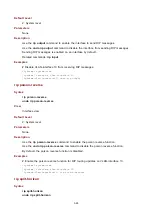
3-31
update-value
: Update timer time in seconds, in the range of 1 to 3600.
Description
Use the
timers
command to configure RIP timers. By adjusting RIP timers, you can improve
network performance.
Use the
undo timers
command to restore the default.
By default, the garbage-collect timer is 120 seconds, the suppress timer 120 seconds, the
timeout timer 180 seconds, and the update timer 30 seconds.
RIP is controlled by the above four timers.
z
The update timer defines the interval between routing updates.
z
The timeout timer defines the route aging time. If no routing update related to a route is
received after the aging time, the metric of the route is set to 16 in the routing table.
z
The suppress timer defines how long a RIP route stays in the suppressed state. When the
metric of a route is 16, the route enters the suppressed state. In the suppressed state, only
routes which come from the same neighbor and whose metric is less than 16 will be
received by the router to replace unreachable routes.
z
The garbage-collect timer defines the interval from when the metric of a route becomes 16
to when it is deleted from the routing table. During the Garbage-Collect timer length, RIP
advertises the route with the routing metric set to 16. If no routing update is announced for
that route after the Garbage-Collect timer expires, the route will be deleted from the routing
table.
Note that:
z
Generally, you are not recommended to change the default values of these timers.
z
The time lengths of these timers must be kept consistent on all routers in the network.
Examples
# Specifies the update, timeout, suppress, and garbage-collect timers as 5, 15, 15 and 30
respectively.
<Sysname> system-view
[Sysname] rip 100
[Sysname-rip-100] timers update 5 timeout 15 suppress 15 garbage-collect 30
validate-source-address
Syntax
validate-source-address
undo validate-source-address
View
RIP view
Default Level
2: System level
Parameters
None
















































